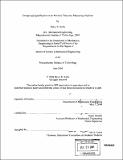Design and qualification of an absolute thickness measuring machine
Author(s)
Kelly, Darcy K. (Darcy Kendal), 1980-
DownloadFull printable version (12.23Mb)
Other Contributors
Massachusetts Institute of Technology. Dept. of Mechanical Engineering.
Advisor
Samir Nayfeh.
Terms of use
Metadata
Show full item recordAbstract
The target fabrication group at Lawrence Livermore National Laboratory develops various high energy density physics targets, which are used to study the interaction of materials when shot with high energy lasers. These targets consist of many different types of materials glued together including low density foams, plastics, and metals. To verify models, the physicists need to know the exact thickness of the targets and target components to [plus-minus] 1.0 [mu]m. The target components are typically 3-5 mm in diameter and 200-300 [mu]m thick and may have features such as moguls or two-dimensional sine waves machined onto them. As of yet, no commercial thickness measuring machine exists on the market capable of measuring thicknesses to [plus-minus] 1.0 [mu]m. To solve this problem, an absolute thickness measuring machine was developed that uses a precision air-bearing XY stage to scan a target between two confocal displacement lasers that measure the profile of each side of the target. A NIST traceable gage block of known thickness is used to calculate the thickness of the target. This paper describes the design and qualification of the absolute thickness measuring machine. It focuses on the error budget and tests performed to qualify the machine. Without compensation factors, the absolute thickness measuring machine was able to measure the thickness of a gage block to 0.5 [mu]m.
Description
Thesis (S.M.)--Massachusetts Institute of Technology, Dept. of Mechanical Engineering, 2004. Includes bibliographical references (leaf 68).
Date issued
2004Department
Massachusetts Institute of Technology. Department of Mechanical EngineeringPublisher
Massachusetts Institute of Technology
Keywords
Mechanical Engineering.